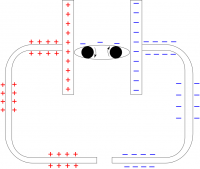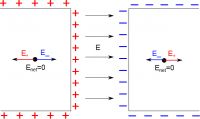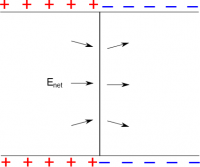Connecting a Circuit: Before Steady State
So far, we have talked about how to model batteries and electron current for a steady state current (meaning the wire has been connected for some time). We found that there must be a constant, continuous electric field along the wire that comes from the wire's surface charges to push the electron current through the wire to the battery. But what happens before the steady state current is reached? These notes will go into detail about how a steady current is produced and what happens in the circuit immediately after it is connected.
Before the wires are connected
Suppose we have a battery, with one positive end and one negative end (could be either the chemical model or mechanical model of the battery). At each end, we connect a conductive wire. Before we connect the wires, what would the charge distribution look like along the wire?
The wire that is connected to the negative end of the battery would have a negative distribution of charge because the excess electrons would be able to spread along the length of the wire. Since the wire is a conductor, those excess charges would spread out along the surface of the wire, leaving the interior of the wire with a net electric field equal to zero. A similar process would occur for the wire connected to the positive end of the battery. An approximate charge distribution is shown in the figure, ignoring the exact details of the charge distribution.
If we zoom in on the gap between the wires, We can see an electric field at the end of the wires; however that electric field is cancelled out by the electric field from the wire across the gap. So even in the ends of the wires, the net electric field is zero.
Immediately after the wires are connected
If we complete the circuit by connecting the wires, what happens to the surface charges in the wire? The charges on the ends of the wires neutralize each other (so there is no net charge in the middle of the wires). This leaves a “tube” of surface charge on the outside of the wire. In the instant that the two wires touch, there is a strong discontinuity in the charge distributions along the wires - one side of the wire is positive and one side is negative with no smooth transition between the two. This means that there is a separation of charge and therefore there is now an electric field in the now-touching ends of the wires.
A moment after the wires are connected
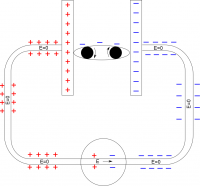 Because there is now an electric field in the wire, the mobile sea of electrons will start to move, which changes the surface charge distributions. Note that this starts happening after only fractions of a nano-second. Electrons moving toward the positive region of the wire will make the surface charge in that region less positive. Likewise, electrons moving away from the negative region of the wire will make that region less negative. In the middle of the wires, this creates a region with smaller amounts of charge, making that discontinuity of positive and negative charges less drastic, and setting up an electric field between the positive and negative regions.
Because there is now an electric field in the wire, the mobile sea of electrons will start to move, which changes the surface charge distributions. Note that this starts happening after only fractions of a nano-second. Electrons moving toward the positive region of the wire will make the surface charge in that region less positive. Likewise, electrons moving away from the negative region of the wire will make that region less negative. In the middle of the wires, this creates a region with smaller amounts of charge, making that discontinuity of positive and negative charges less drastic, and setting up an electric field between the positive and negative regions.
A short time after the wires are connected
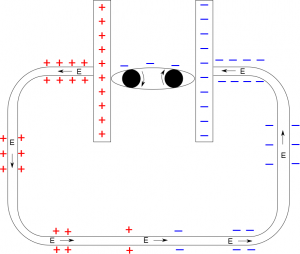 Again moments later (fractions of nano-seconds), the charge distributions in each side of the wire have rearranged. The excess negative charges have spread out so they have shifted away from the battery and more towards the center of the wire, with a similar process occurring for the positive charges. This creates regions in the wires where close to the battery there is a more concentrated surface charge and closer to the center there is a weaker surface charge. This sets up the continuous charge distribution that we see for the steady state. With this continuous charge distribution, there is now an electric field set up within the wire, which starts to move the electrons in the electron current.
Again moments later (fractions of nano-seconds), the charge distributions in each side of the wire have rearranged. The excess negative charges have spread out so they have shifted away from the battery and more towards the center of the wire, with a similar process occurring for the positive charges. This creates regions in the wires where close to the battery there is a more concentrated surface charge and closer to the center there is a weaker surface charge. This sets up the continuous charge distribution that we see for the steady state. With this continuous charge distribution, there is now an electric field set up within the wire, which starts to move the electrons in the electron current.
How long does this process take?
The electric field from the surface charges is set up between the two wires almost instantaneously. That electric field immediately starts pushing on the electrons in the region (from the electron sea), which then move. The electrons do not have to move very far to change the surface distribution of charge, which extends the electric field around the circuit. This causes a push on the electron in the region of the extended electric field, and so on. This means that the electric field is able to travel around the wire much more quickly than the individual electrons in the wires. In fact, the electric field travels at the speed of light ($3*10^8$ m/s), while the electrons in the wires are only traveling at close to $5*10^{-5} m/s$. So the circuit reaches a steady state long before a single electron makes a whole loop around the circuit.
This explains why when you turn on a switch, the light comes on almost immediately. You are not waiting for an electron from the switch to travel all the way to the lightbulb. You are waiting for an electric field to be set up in the wire to push the electrons that are already in and near the light bulb. Thankfully that process is much shorter!
